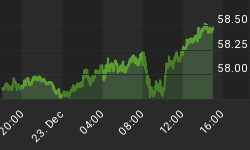Using weekly and monthly charts we can get a clearer view of macro events happening in the big picture while tuning out some of the short-term noise. By now, the stock market is making a monkey out of most people who try to get into the crystal ball business. Volatility has been all but wrung out of this market even as the collective political mindset is enraged and the social mindset can't seem to shake the feeling that "something is rotten in Denmark". I myself, while unable to take advantage of this remarkable run in conventional stocks due to trading disciplines, continue watching from a stock market neutral, moderately long precious metals and resources (for a trade or longer, with high cash %) position while waiting for clues as to what is to come. The longer term charts foretell big changes in the offing, although they are not necessarily going to be what the majority expects. But even there, I believe the majority's expectations are in flux. Let's see how much longer Bully can sing its siren song and inflation expectations can remain well-contained.






1) The broad stock market, as represented by the S&P 500 has been breaking resistance lines like small twigs as it rampages higher, day after bullish day. The market is extremely over-bought, but in what looks more and more like a blow-off in the making, it does not seem to matter in the short-term. This is more than short covering and the longer this market is doubted, the longer it will continue. We call this the "suck-in" and regardless of how artificial and downright silly the Dow or SPX's daily charts look, reality is reality; lots of support levels have been built in to this market.
2) The VIX remains decidedly not bullish (for the market) by its weekly chart. Falling wedge back to the lows. Another extreme. The caveat here is that these gyrations can take what seems like forever to play out, especially if you are actively betting one way or the other. But suffice it to say, you want to have been buying VIX 22+, not VIX 10 if you value risk vs. reward metrics that is.
3, 4, & 5) Here is where fuel for the stock market's short-term Goldilocks scenario and the resource sectors' pain is being manufactured. The Fed came out with an exceedingly dovish (limp) release earlier this week and just as happened following the Fed's first decision to pause, the bond market celebrated in blind obedience to the all-knowing Federal Reserve. This is where I believe assumptions are being cemented (growth slowing, inflation no longer an issue) and where the upcoming changes will be generated from. The $TNX did break its downtrend and is now in the process of testing that break. But this could also be the beginning of the next leg lower! The yield spread ($TNX:$IRX Ratio) has already begun that journey. Precious metal and commodity investors take cautionary note. Finally, wrapping up our look at bond land, we take a look at the long-term monthly chart of the spread. If the bottom is not here, it is likely coming at, you guessed it, an extreme. In my opinion you do not want to be a long-term holder of the debt of chronic inflators, at least not at the expense of owning actual resources and resource companies. 2001 began a secular (until proven otherwise) trend change toward hard assets and away from debt backed financial instruments.
6) Why can't I personally invest in this great American story? Because the US Dollar is intrinsically worthless regardless of its exchange price (bullish to these eyes). You know it, I know it and the rest of the world knows it too. Regardless of how long it takes for the global currency scheme (all backed by unserviceable debt) to play out, the advise is simple; pay off/down debt, actually own what you own and seek out productive investments. If Goldlilocks can continue avoiding the bears indefinitely, with all those trillions of debt notes in tow, more power to her. I don't believe it. But timing as always is an issue.
Here is the real-world crux of the matter: My company's business is quite good, and we are not the only US manufacturer saying that. Machine tool suppliers I speak with are talking boom. We are talking about expensive ($200,000 to $500,000 machines) equipment; productive equipment. Japan and China continue to boom and global growth remains intact. US commercial real estate continues unabated in the face of the consumer's ATM meltdown in the leveraged mortgage sector. Here is an excerpt from an email I received yesterday from a general partner at a recruitment firm: "I am a partner of a medium sized recruiting firm, and would have to agree with you that business is good." The bond market doesn't think so. The bond market thinks growth is slowing in a controlled manner and there is no residual and unproductive liquidity sloshing around in the system. The bond market, in its assumption of slowing growth is actually helping to fund and fuel asset markets. But will the Fed follow suit by cutting rates? I don't believe so. Yes, we have slowing in some dangerous areas, but we also have what feels like pre-hyperinflationary asset appreciation in others. Goldilocks thinks she is backed by a steady slowing of growth to normalized levels. The call here is that there is nothing normal about extreme stagflation.















